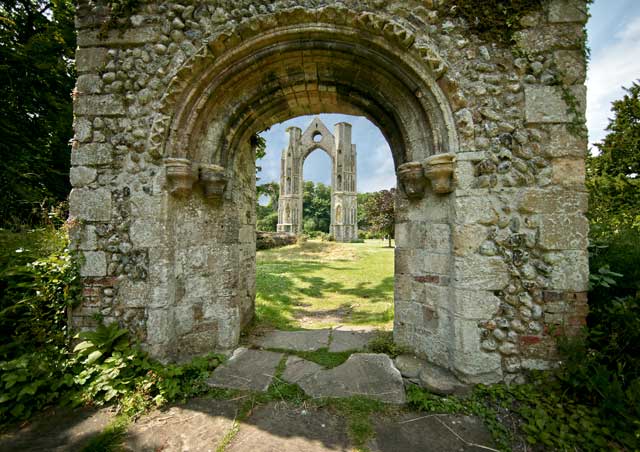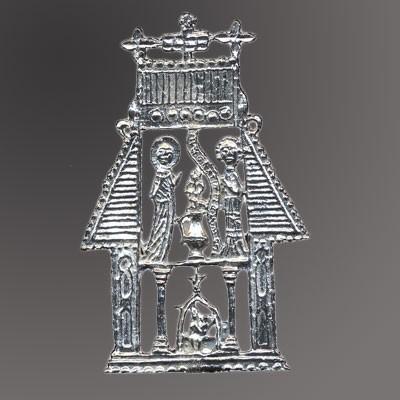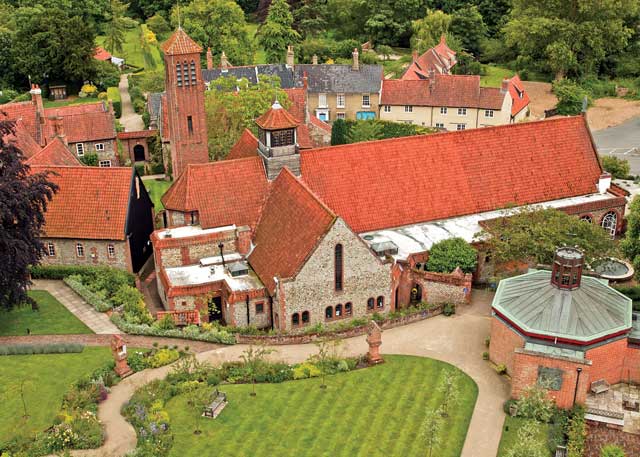
In 1061, almost 1000 years ago, and some years before the Norman Conquest of England, a noble widow lived in the small town of Walsingham. Her name was Rychold, and she was a devout and godly woman. She prayed, asking the Virgin Mary to guide her into some good work that she could perform out of her love for Christ and his Virgin Mother.
The Virgin St Mary appeared to her in that place, and led her in the spirit to Nazareth, and showed her the house in which she received the Annunciation of the Lord Jesus Christ, our God and Saviour, and she asked Rychold to make a replica of the same house in Walsingham. The account of this heavenly vision reports…
“O daughter, consider” to her Our Lady said,
”Of this place take surely the measure,
Another like this at Walsingham make
Unto my praise and singular honour;
All that seek me there shall find succour,
Where shall be had in a memorial
The great joy of my salutation.
First of my joys, origin and source,
Root of mankind’s gracious redemption,
When Gabriel gave to me relation
To be a mother through humility.
And God’s Son conceive in virginity”
We learn that after this encounter with the Virgin Mary, and this vision of the house of Nazareth, she set about instructing her workmen to construct an exact likeness. There was a meadow in her estate, and it was covered that morning with dew when she went out to see where the house might be built in honour of the Annunciation. There were two places where it seemed that miraculously the ground was dry and there was no dampness at all. In the first of these, near to two wells, she instructed her craftsmen to begin. But they seemed to face unceasing obstacles in their work, and the pieces of timber they cut would not join with one another.
Rychold turned to prayer and spent the whole night asking that the Virgin Mary who had instructed her to provide this memorial of the Annunciation would bring it to completion.
Our blessed Lady, with heavenly ministries,
Herself being here chief artificer,
Raised this said house with angelic hands,
And not only raised it but set it where it is,
That is, two hundred feet and more in distance
From the first place books make remembrance.
For 500 years pilgrims made their way to Walsingham, to honour the Virgin St Mary, and to pray at this little shrine she had constructed, and which came to be enclosed in stone, and around which a Priory grew up. The ruins of this Priory are still visible in Walsingham. This holy place became as important a place of pilgrimage as Rome, Jerusalem and Santiago da Compostella. Pilgrims came to honour the Virgin Mary and to pray at the copy of the house of the Holy Family of Nazareth and at the place where she had appeared in England.

All was swept away in the 16th century, by King Henry VIII and his Protestant advisers. The wooden statues of Christ and our Lady were taken to London and burnt by wicked men, and everything was destroyed. But pilgrims returned in the late 19th century, and still make their way to the peace of Walsingham, and offer prayers and praises to God, in remembrance of his mother.

There is a new shrine church and pilgrim centre, and a copy of the holy house has been constructed which includes some of the remains from the priory. Anglicans, Catholics and Orthodox have chapels and churches in the village, and there are annual pilgrimages that draw thousands again, as well as a steady stream of pilgrims each day.
We should not forget this important event, the appearance of the Virgin Mary in England, 960 years ago, and her instruction which the holy Rychold fulfilled, to bring Nazareth to England. This small village remains a place of prayer and pilgrimage, and all those who love the Virgin Mary should try to visit and pray in the shrine and visit the ruins, including the place where the wooden copy of the holy house once stood.
It was once said of this place,
O England, great cause you have to be glad,
Compared to the land of promised Zion,
You attained my grace to stand in that place
Through this glorious Ladies assistance,
To be called in every realm and region
The holy land, Our Ladies dowry;
Thus art you named of old antiquity.
And this is the cause, as it appears by likeness,
In you is built a new Nazareth, a house
To the honour of the heavenly empress
And of her most glorious salutation,
Chief principal and ground of our salvation,
When Gabriel said at old Nazareth ‘Ave’,
This joy here daily remembered for to be.
O gracious Lady, glory of Jerusalem,
Cypress of Zion and Joy of Israel,
Rose of Jericho and Star of Bethlehem,
O glorious Lady, our asking do not repel,
In mercy all women ever you do excel,
Therefore, blessed Lady, grant your great grace
To all that the devoutly visit in this place.
